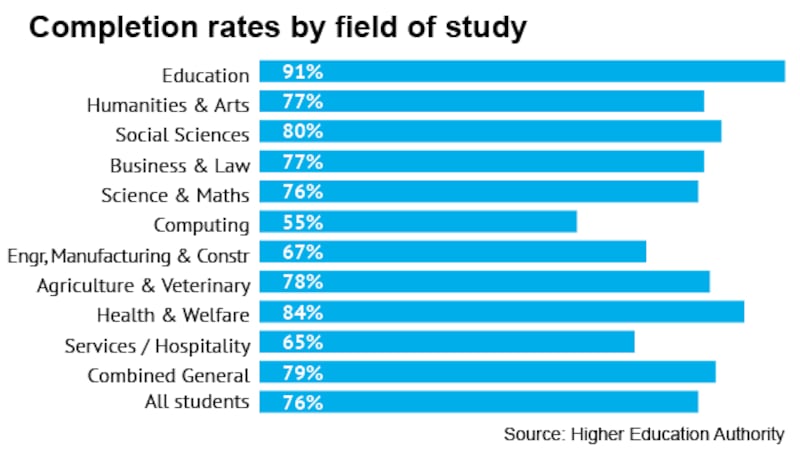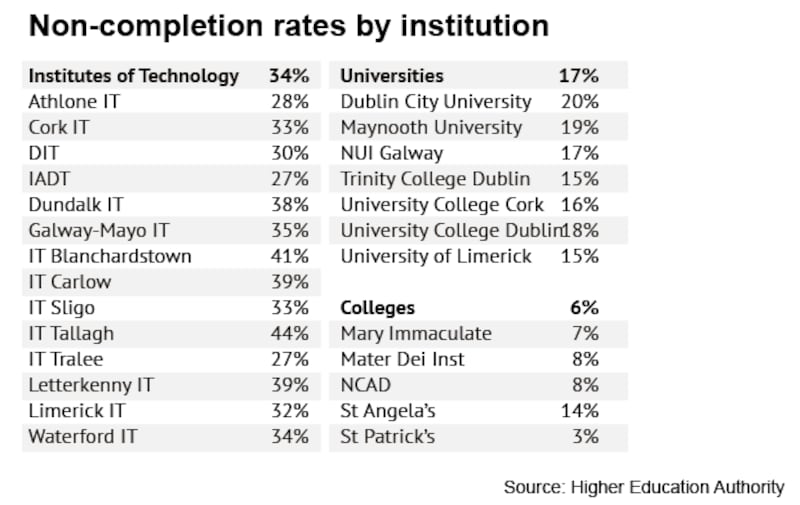Male students with relatively low Leaving Cert points are at the highest risk of failing to complete their third-level course.
New figures show the proportion of students completing their third-level course is much higher among women (81 per cent) than men (71 per cent).
Females also outperform males academically, with a higher proportion of women achieving a first class or 2:1 degree in their final exams.

High drop-out rates are a major issue for young men, especially those studying computing courses in institutes of technology. Almost 60 per cent of these students failed to complete these courses at ordinary degree or higher certificate level.
The findings are contained in a study by the Higher Education Authority which tracked more than 34,000 students who started courses at third level in the 2007/08 academic year (following up on them over a 10-year period).

The gender gap in present across all institutions and levels of study, although it varies significantly across different colleges and levels of study.
For example, in IT Blanchardstown most males (52 per cent) are not completing their courses, while the equivalent rate for women is far lower (29 per cent).
By contrast, in UCD the non-completion rate for males and females was the same (18 per cent).
This, the report says, indicates that socio-economic factors may be more influential on male completion rates given that UCD is in a more affluent area.
Higher points
Another key factor is the difference in Leaving Cert points on entry, given that females tend to enter with significantly higher points.
There is also evidence that more affluent students are more likely to complete higher education, though the picture is mixed.
For example, students from “higher professional” and farming backgrounds have the lowest drop-out rates (16 per cent), while those from a semi-skilled background had the highest (29 per cent).
Students from disadvantaged schools had a higher non-completion rate (35 per cent) compared with standard schools (28 per cent) and fee-paying schools (24 per cent).
Yet students from disadvantaged backgrounds perform just as well as those from affluent backgrounds in select high-points courses, with a drop-out rate of between 9 per cent and 10 per cent.
For Dublin students, based on postal code, students from Dublin 4 and Dublin 6 have the highest completion rates at 87 per cent and 85 per cent respectively. Those from Dublin 24 and Dublin 10 have the lowest completion rates at 67 per cent and 65 per cent respectively.
Country
When the figures are broken down according to what country students have come from they also show striking differences.
Indian students had the highest non-completion rates (50 per cent), while Chinese also had a higher than average drop-out rate (28 per cent).
The non-completion rate for Irish students (24 per cent) is in line with the overall average.
Non-Irish students were more likely than their Irish counterparts to achieve a first-class honours or a 2:1.
One of the most striking findings in the study is the relationship between prior academic achievement and student success.
Students entering higher education with lower Leaving Cert points are more likely to not complete their course when compared to their higher-achieving peers.
For example, a student who entered college with between 505 and 550 Leaving Cert points has a 6 per cent likelihood of dropping out.
This compares with a 51 per cent chance of dropping out for students who enter with between 205 and 250 Leaving Cert points.













